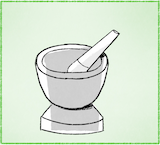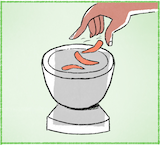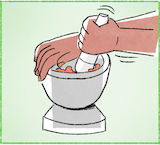


นี้คืออี่หยัง อันนี้กะเป็นคก เป็นคกกับสาก เป็นของคู่กัน สองอันนี้ใซ้งานคู่กัน
คกกับสากกะมีหน้าที่ว่าเอาไว้ถ้าตำ ตำอี่หยังกะได้ ตำบักพิกกะได้ ตำเข้าสานกะได้ ตำอี่หยังกะได้ เพื่อที่ว่าอยากให้สิ่งนั้นมันแหลก หลือว่าอยากให้สิ่งนั้นมันมุ่น มุ่นอุ้ยปุ้ยนั้นหละความหมายหนะ
19
เขากำลังเฮ็ดหญัง คนคนหนึ่งเขากำลังเอาบักพิกลงไปในคก
เขาเอาบักพิกลงไปในคกเฮ็ดหญัง เขาอาดสิเอามาตำ อาดสิเอาบักพิกนี้มาตำ อาดสิอยากให้บักพิกนี้มันแหลก หลือว่าให้มันมุ่นนั้นเอง เขากะเลยสิเอามาตำ
เขาเอาบักพิกลงไปจักน่วย ที่แนมเห็นกะมีอยู่สามน่วย บักพิกมีอยู่สามน่วย บ่ได้มีหลายซ้ำ เขากำลังโญนลงไปในคก
แล้วบักพิกน่วยใหญ่บ่ กะน่วยบ่ใหญ่ปานใดดอก กะน่วยพอปะมาน
แล้วเขาสิตำบักพิกเฮ็ดหญัง เขาอาดสิเอาไปเฮ็ดแนวกิน หลือว่าเอาไปปุงแนวกิน เขาอยากให้แนวกินนั้นลดซาดมันจัดๆ หลือว่าลดซาดมันเผ็ด เขากะเลยสิเอาบักพิกนี้มาตำ แล้วกะเอาไปปุงแนวกินนั้นเอง
20
เขากำลังเฮ็ดหญัง เขากำลังตำบักพิก
เขาใซ้มือข้างซ้ายของเขาจับสาก อีกข้างหนึ่งกะข้างขวาจับคกบัดหนิ เขากะใซ้มือข้างซ้ายของเขาตำๆๆ จับสากแล้วกะตำๆๆๆ บักพิกเนาะ
เป็นหญังเขาคือตำบักพิก เขาอาดสิอยากให้บักพิกนั้นมันแหลก เขากะเลยสิตำบักพิก เอาสากตำบักพิกลงไปในคกเนาะ
แล้วเขาตำแฮงบ่ กะสิตำแฮงอยู่ กะสิใซ้แฮงหลาย ขั้นตำค่อยบักพิกกะบ่แหลก บักพิกกะบ่มุ่น ขั้นตำแฮงบักพิกกะสิมุ่น บักพิกกะสิแหลก
Link to overview page
Link to dictionary
| Isaan | Pronunciation | Tones | Thai | English/Notes |
|---|---|---|---|---|
| นี้ | ni: | HF | นี้ | 1. this 2. here |
| คือ | khʉ: | HR | คือ | 1. to be, to resemble, like, as 2. why {บักหล้าคือบ่เก็บโต่ะแน่ = [addressing a young boy] Why haven't you cleared the table?} |
| อี่หยัง | i:-yaŋ | H-M | อะไร | 1. what {นี้คืออี่หยัง = What is this?} {มื้อนี้เจ้าเฮ็ดอี่หยัง = What are you doing today?} {กินเข้างายกับอี่หยัง = What did you have for breakfast?} 2. something, anything, (in negations) nothing {บ่ต้องเฮ็ดอี่หยังอีกเลยนอกจากใส่ปุย = [we] don't need to do anything besides adding fertilizer} |
| อัน | an | M | อัน | 1. thing, object 2. general clf. for objects |
| กะ | ga | M | ก็ | 1. then, consequently 2. also |
| เป็น | pen | M | เป็น | 1. to be, to exist 2. to be able to 3. to suffer, sth. happens to 4. เป็นหญัง[...]คือ in initial position: why? {เป็นหญังเขากะคือแปงฟัน = Why is he brushing his teeth?} {เป็นหญังเคี่ยงบินมันคือสิตก = Why is the airplane falling down?} |
| คก | khok | H | ครก | mortar (for crushing chili paste etc.) |
| กับ | gap | M | กับ | 1. and {ลุงกับป้า = uncle and aunt} {กวยเตียวหมูกับกวยเตียวไก่ = noodle soup with pork and noodle soup with chicken} 2. with, to {ค้ายๆ กับคำว่า ... = similar to the word ...} 3. prefix in front of foods {กับเข้า = side dishes eaten with rice} {เขากินกับกวยเตียว = he's eating noodle soup} |
| สาก | sa:k | LF | สาก | pestle |
| ของ | khɔ:ŋ | M | ของ | of, belonging to |
| คู่ | khu: | H | คู่ | 1. pair, couple 2. to be paired with |
| กัน | gan | M | กัน | mutual, each other, with another, together {เขากำลังนั่งเว้ากัน = they're sitting and talking} {เขาสองคนฮักกัน = they love each other} {ปาสองโตนี้ ใหญ่ห่างกันหลายบ่ = These two fish here, are they very different in size (from each other)?} {ต่างกัน = to be different (from each other)} {ก่องอันไหนหนักกว่ากัน = Which box is heavier (than the other(s))?} |
| สอง | sɔ:ŋ | M | สอง | two |
| ใซ้งาน | sai-ŋa:n | HF-HR | ใช้งาน | to use, to put to use |
| มี | mi: | HR | มี | 1. to have 2. there is |
| หน้าที่ | na:-thi: | LF-H | หน้าที่ | duty, responsibility, obligation, function |
| ว่า | wa: | H | ว่า | 1. that, as {คำว่า X = the word X} 2. to say |
| เอา | ao | M | เอา | to take, to give {เขากำลังเอาก่องไปซั่ง = he's taking the boxes to weigh them} {หมอกำลังเอายาให้คนป่วยกิน = the doctor is giving medicine to the patient} {เอาไว้ถ้า = is for, is used for, has the purpose of} |
| ไว้ถ้า | wai-tha: | HF-LF | usually in a positive statement or answer: is for, is used for, has the purpose of {กะทะมีไว้ถ้าทอด = a pan is for frying} {น้ำบักนาวมีไว้ถ้าปุงอาหาน = lime juice is used to season food} {ปากกามีไว้ถ้าเขียน = a pen is for writing} {กะเทียมเอาไว้ถ้าเฮ็ดแนวกิน = garlic is used to make food} {ขาเอาไว้ถ้าญ่าง = legs are for walking} {เกิบเอาไว้ถ้าใส่ = shoes are for wearing} Notes: see also ไว้ |
|
| ตำ | tam | M | ตำ | 1. to hit 2. to bump into 3. chili, garlic etc.: to pound |
| ได้ | dai | HF | ได้ | 1. can 2. to get, to obtain 3. before verb: indicating past tense 4. บ่ได้ + verb: not |
| บักพิก | bak-phik | M-H | พริก | chili |
| เข้าสาน | khao-sa:n | LF-M | ข้าวสาร | rice, white rice |
| เพื่อที่ | phʉ:a-thi: | H-H | เพื่อที่ | in order to, so that Notes: the vowel เอือ is likely to be a Thai loan |
| อยาก | ya:k | LF | อยาก | to want, to wish |
| ให้ | hai | LF | ให้ | 1. to give {หมอกำลังเอายาให้คนป่วยกิน = the doctor is giving the patient medicine} 2. for 3. to allow, to be allowed |
| สิ่ง | siŋ | H | สิ่ง | thing, object |
| นั้น | nan | HF | นั้น | that, there |
| มัน | man | HR | มัน | it (also used to refer to people) |
| แหลก | lɛ:k | LF | แหลก | to be crushed, pulverized, pounded in a mortar |
| หลือ | lʉ: | M | หรือ | or |
| มุ่น | mun | H | แหลกละเอียด | small/fine, pounded, powdery/powder-like |
| อุ้ยปุ้ย | ui-pui | HF-HF | แหลกละเอียด | small/fine, pounded, powdery/powder-like |
| นั้นหละ | nan-la | HF-M | นั่นแหละ | auxiliary for emphasis at the end of a phrase |
| ความหมาย | khwa:m-ma:i | HR-M | ความหมาย | meaning |
| หนะ | na | M | final particle | |
| เขา | khao | M | เขา | personal pronoun: he, she |
| กำลัง | gam-laŋ | M-HR | กำลัง | auxiliary indicating continuous or progressive action |
| เฮ็ด | het | H | ทำ | to do, to make |
| หญัง | ɲaŋ | M | อะไร, เป็นหญัง = ทำไม | 1. what {เขากำลังเฮ็ดหญัง = What is he doing?} {ธูปเอาไว้เฮ็ดหญัง = What are incense sticks for?} 2. something, anything, (nothing) 3. เป็นหญัง[...]คือ in initial position: why {เป็นหญังเขาคือใส่บักพิกลงไปในกวยเตียว = Why is he putting chili in [his] noodle soup?} {เป็นหญังหน้าต่างมันคือเปิด = Why is the window open?} {เป็นหญังมันคือมีควนไฟ = Why is there smoke?} |
| คน | khon | HR | คน | person, people |
| หนึ่ง | nʉŋ | H | หนึ่ง | 1. one 2. after adjective: intensifier {บักคักหนึ่ง = very much} {อันบักใหญ่หนึ่ง = very large}, or attenuates the meaning {กะดาดมันแผ่นน้อยๆ หนึ่ง = the piece of paper is [relatively] small} |
| ลง | loŋ | HR | ลง | 1. to descend, to lower, to go down 2. down 3. bus/train etc.: to get off, to disembark {คนกำลังลงลดบั่ด = people are getting off the bus} 4. boat/ship etc.: to get on, to board {เขากำลังญ่างลงเลีย = he's boarding/getting on the boat} |
| ไป | pai | M | ไป | 1. to go 2. auxiliary indicating action extending into the future |
| ใน | nai | HR | ใน | in, within |
| อาด | a:t | LF | อาจ | 1. might, may, will 2. likely |
| สิ | si | M | จะ | future tense auxiliary {เขากำลังสิตื่น = he's about to wake up} {สิไปตะหลาด = [I'm] going to the market} |
| มา | ma: | HR | มา | 1. to come 2. auxiliary expressing action towards the present or focal time {กะคุเฮ็ดมาจากอี่หยัง = What is the bucket made of?} {แล้วเขากะเก็บเงินจากพุนั้นมา = and then she takes the money of that person} |
| นั้นเอง | nan-e:ŋ | HF-M | นั่นเอง | 1. there 2. sure enough 3. emphasizes that the preceding is the topic or has been mentioned before Notes: Thai loan |
| เลย | lə:i | HR | เลย | 1. futher on, beyond, past {เข็มน้อยเลยเลขสิบสองไป = the minute hand has passed number twelve} 2. too much 3. at all 4. definitively 5. completely, utterly |
| จัก | jak | M | จัก | 1. answer to a question: [I] don't know, don't know exactly, [I'm] not sure {พุซายคนนี้เขาเถ้าไป่ จัก จักเถ้าหลือบ่เถ้า เบิ่งบ่ค่อยออก = Is this man here already old? I don't know. I can't see clearly whether he's old or not.} {เขาเว้ากันอยู่ใส จักคือกัน = Where are they talking? I don't know either.} 2. exact(ly), what exactly {จักต้มอี่หยังกะบ่ฮู้ = I don't know what (exactly) he is cooking} {บ่ลู้คือกันจักปาอี่หยัง = I don't know either what kind of fish this is} 3. how much/many? {ต้นไม้มีจักต้น = How many trees are there?} {ตอนนี้จักโมงแล้ว = What time is it now?} {มือของเฮานี้สิมีจักนิ้ว = How many fingers do our hands have?} 4. a bit, a little bit {จักหน่อย/จักหน่อยหนึ่ง = a bit, a little bit} |
| น่วย | nu:ai | H | ลูก, ผล | clf. for the fruits (e.g., banana, coconut, lime, papaya, watermelon), vegetables (e.g., chilis), eggs, mountains, the sun |
| ที่ | thi: | H | ที่ | 1. that, which {คนที่ยืนอยู่ฝั่งขวา = the person which is standing on the right = the person standing on the right} {เว้าคำที่บ่สุพาบ = to speak words which are impolite = to speak impolitely} 2. for ordinal numbers {ที่สาม = third} |
| แนม | nɛ:m | HR | มอง | to look, to glance, to stare {เขากำลังยืนแนมก้อนหินอยู่ = he's standing and looking at the stone/rock} {ข้างหนึ่งแนมเห็น อีกข้างหนึ่งแนมบ่เห็น = [we] see one side, [we] can't/don't see the other side} |
| เห็น | hen | M | เห็น | to see |
| อยู่ | yu: | H | อยู่ | 1. to be (located) at 2. yet, still 3. auxiliary indicating continuous or progressive action {ทอดปาอยู่ในกะทะ = (in the process of) frying a fish in the pan} {แม่กำลังเมี้ยนเฮียนอยู่ = mother is cleaning/tidying up the house} |
| สาม | sa:m | M | สาม | three |
| บ่ | bɔ: | H | ไม่ | 1. no, not 2. question particle, transforming a statement into a question Notes: spelling exception in line with common usage on social media |
| หลาย | la:i | M | เยอะ, มาก | many, much, very |
| ซ้ำ | sam | HF | อีก(เลย) | again, once more, anymore Notes: translation to be confirmed |
| โญน | ɲo:n | HR | โยน | to throw, to toss {โญนลูกบอน = to throw a ball} |
| แล้ว | lɛ:o | HF | แล้ว | 1. finished 2. already 3. and then, and next (especially แล้วกะ) 4. auxiliary for past tense |
| ใหญ่ | ɲai | H | ใหญ่ | large, big |
| ปานใด | pa:n-dai | M-M | เท่าไหร่, มาก | 1. after negative: (not) very, (not) so much {บ่ใหญ่ปานใด = not so large, not very large} 2. how much, how many {เฮาบ่สามาดนับได้ว่ามันมีหลายปานใด = it's impossible to count how many there are} |
| ดอก | dɔ:k | LF | หรอก, ดอก | 1. particle used after a negative, relativizing or explanatory statement to make the sense milder {กินเข้าบ่ บ่กินดอก = Are you going to eat [with us]? No.} {เป็นก้อนสี่เหลี่ยม ก้อนน้อยๆ ดอก = These are cubes, small cubes.} {แล้วกะมีลดคันหนึ่งขี่ผ่านมา เป็นลดเก็งดอก = And there's a car passing, a sedan.} 2. particle used to emphasize (not necessarily a negative) contrast 3. particle used for emphasis {ดอกไม้นี้งามบ่ กะงามอยู่ เบิ่งงามๆ ดอก = Is this flower beautiful? Yes, it's beautiful, it looks beautiful} |
| พอปะมาน | phɔ:-pa-ma:n | HR-M-HR | พอประมาณ | moderately |
| แนวกิน | nɛ:o-gin | HR-M | อาหาร | food {เฮ็ดแนวกิน = to prepare food} {ตำบักหุ่งเนี้ยกะสิเป็นแนวกิน = papaya salad is (a kind of) food} |
| ปุง | puŋ | M | ปรุง | to season, to flavor, to cook, to mix, to combine {ปุงกาแฟ = to season coffee, i.e., to add sugar} {ปุงกวยเตียว = to season noodle soup (e.g., with chili, fish sauce, vinegar, sugar etc.)} |
| ลดซาด | lot-sa:t | H-HF | รสชาติ | taste Notes: pronunciation: also realized as ลดชาด |
| จัด | jat | M | จัด | intense, strong, concentrated |
| เผ็ด | phet | M | เผ็ด | spicy, hot |
| ใซ้ | sai | HF | ใช้ | to use |
| มือ | mʉ: | HR | มือ | 1. hand 2. front leg/paw (e.g., of a cat) |
| ข้างซ้าย | kha:ŋ-sa:i | LF-HF | ข้างซ้าย | left, (on the) left side |
| จับ | jap | M | จับ | 1. to grasp, to hold {เขาจับมือกัน = they're holding hands} {เขายืนจับไอติมอยู่ = she's standing, holding an ice cream} 2. to catch, to arrest {จับพุล้าย = to arrest a criminal} |
| อีก | i:k | LF | อีก | 1. more, again 2. other, another |
| ข้าง | kha:ŋ | LF | ข้าง | 1. side {มีหูจับสองข้าง = there are handles on both sides} 2. next to {วางอยู่ข้างๆ ก่องใบใหญ่ = it's placed next to the large box} {เขายืนอยู่ข้างๆ อีกพุหนึ่ง = he's standing next to another person} 3. clf. for body parts which come in pairs (eyes, ears, legs etc.) {เขามีตาสองข้าง = she has two eyes} |
| ข้างขวา | kha:ŋ-kwa: | LF-M | ข้างขวา | right, (on the) right side |
| บัดหนิ | bat-ni | M-M | [...] บัดหนิ = ทีนี้ [...] | final particle: adds a sense of immediacy |
| เนาะ | nɔ | H | เนาะ | final particle: makes the statement softer, looking for agreement |
| แฮง | hɛ:ŋ | HR | แรง | 1. strong {ลมกำลังพัดแฮงอยู่ = to wind is blowing strongly} 2. loud {เสียงแฮง = loud} 3. strength, power |
| ขั้น | khan | LF | เมื่อ | when, if |
| ค่อย | khɔ:i | H | ค่อย | 1. soft, gentle 2. little by little, gradually |